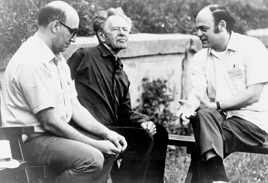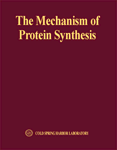|
XXXIV: The Mechanism of Protein Synthesis 1969 |
|
|

|
From left: Dr. Victor Shashoua, Dr. Fritz Lipmann, Dr. Alexander Rich SYMPOSIUM SYNOPSIS LIST OF PARTICIPANTS CONTENTS OF SYMPOSIUM VOLUME PHOTOGRAPHS PUBLISHED VOLUME  |
The Mechanism of Protein Synthesis
5–12 June, 1969
Symposium Synopsis
Organizer: John Cairns
Advisors: Raymond Gesteland, Peter Lengyel, Fritz Lipmann, Robert Thach and James Watson
The first Cold Spring Harbor Symposium dealing proteins had been held in 1949. Then, Paul Zamecnik noted in his opening remarks for the 1969 Symposium, it was not yet certain that amino acids became incorporated into proteins by peptide bond formation, and that reversal of proteolysis was still considered a possible mechanism. At the 1963 Symposium on Synthesis and Structure of Macromolecules, reports and discussions of protein synthesis occupied only 112 pages but now, in a “...spectacular display of progress...”, a whole Symposium was devoted to the topic. Zamecnik with his colleagues, in particular Mahlon Hoagland, had developed an in vitro system for studying protein synthesis, and with this they had discovered transfer RNAs and shown how these carried amino acids for protein synthesis. By 1961, messenger RNA had been detected, and in the 1960s, the ribosome, the site of protein synthesis, became the object of intense research.
This Symposium, then, reported a vast quantity of data. No fewer than 20 papers dealt with ribosome structure and the formidable complexity of the complex was apparent. Alfred Tissiérres, for example, listed 34 proteins from the E. coli 50S subunit and 20 from the 30S subunit. Given the complexity of the ribosome, there was much interest in how it was assembled and Nomura described the reconstitution of the 30S subunit. Attempts to localize the enzymatic activity responsible for formation of the peptide bond went hand-in-hand with the structural studies, and there were sessions covering the molecular details of initiation, translocation and elongation, and termination.
Indeed, the Symposium seems to be overwhelmed with molecular details, as was the summary given by Peter Lengyel. John Cairns commented in his foreword, “A science comes of age when the principles on which it was founded have been vindicated and are replaced, as an occupation, by the accumulation of detail...” He argued that this was a good thing –“...detail from which, of course, further principles will eventually arise”– but the published volume gives a sense of too much detail and too few principles. That Cairns was correct became clear 32 years later in a spectacular Symposium devoted to The Ribosome (2001).
This was John Cairns’ last Symposium as director of Cold Spring Harbor. In 1968, he resigned from the post although he continued to do research at the Laboratory until 1972. The directorship was assumed by Jim Watson who divided his time between Harvard and Cold Spring Harbor until he came to live at the Laboratory in 1972.
Search images: